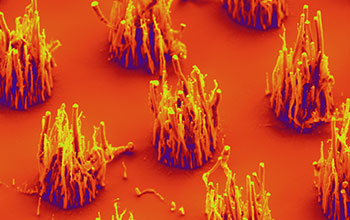Multimedia Gallery
Researchers grow carbon nanofibers using ambient air
Researchers have shown they can grow vertically aligned carbon nanofibers using ambient air, rather than ammonia gas, making the manufacturing process safer and less expensive.
More about this image
In 2014, researchers from North Carolina State University (NC State) demonstrated that vertically aligned carbon nanofibers (VACNFs) can be manufactured using ambient air -- rather than ammonia air, the conventional technique -- making the manufacturing process safer and less expensive. VACNFs hold promise for use in gene-delivery tools, sensors, batteries and other technologies.
"This discovery makes VACNF manufacture safer and cheaper, because you don’t need to account for the risks and costs associated with ammonia gas," says Anatoli Melechko, an adjunct associate professor of materials science and engineering at NC State and senior author of a paper published on the work. "This also raises the possibility of growing VACNFs on a much larger scale."
The research was supported in part by a grant from the National Science Foundation (NSF) (grant DMR 10-56653).
To learn more about this research, see the NSF News From the Field story Researchers grow carbon nanofibers using ambient air, without toxic ammonia. (Date image taken: 2014; date originally posted to NSF Multimedia Gallery: July 20, 2018)
Credit: Anatoli Melechko/North Carolina State University
See other images like this on your iPhone or iPad download NSF Science Zone on the Apple App Store.
Images and other media in the National Science Foundation Multimedia Gallery are available for use in print and electronic material by NSF employees, members of the media, university staff, teachers and the general public. All media in the gallery are intended for personal, educational and nonprofit/non-commercial use only.
Images credited to the National Science Foundation, a federal agency, are in the public domain. The images were created by employees of the United States Government as part of their official duties or prepared by contractors as "works for hire" for NSF. You may freely use NSF-credited images and, at your discretion, credit NSF with a "Courtesy: National Science Foundation" notation.
Additional information about general usage can be found in Conditions.
Also Available:
Download the high-resolution JPG version of the image. (2.5 MB)
Use your mouse to right-click (Mac users may need to Ctrl-click) the link above and choose the option that will save the file or target to your computer.



